I'm also having some trouble with annotating text to individual facets in ggplot2 (w/ reference to related post: Annotating text on individual facet in ggplot2).
Data frame:
str(cfit_2)
'data.frame': 186 obs. of 5 variables:
$ Participant: Factor w/ 31 levels "2","3","4","5",..: 1 2 3 4 5 6 7 8 9 10 ...
$ Condition : Factor w/ 2 levels "Active control group",..: 1 2 2 2 1 1 2 2 1 1 ...
$ Time : Factor w/ 2 levels "Pretest","Posttest": 1 1 1 1 1 1 1 1 1 1 ...
$ CFIT : num 10 13 17 11 19 15 19 11 15 16 ...
$ Version : Factor w/ 3 levels "Total CFIT","CFIT version 1",..: 1 1 1 1 1 1 1 1 1 1 ...
Code:
p<-ggplot(cfit_2,aes(Time,CFIT,fill=Condition))+
scale_y_continuous(breaks=1:20)+
scale_fill_manual(values=c("white","lightgrey"))+
geom_violin()+
theme_classic()+
coord_cartesian(ylim=c(1, 20),xlim=c(1, 2))+
theme(axis.line=element_blank())+
facet_grid(.~Version)+ylab("CFIT raw score")+
geom_segment(x=.3925,xend=.3925,y=1,yend=20)+
geom_segment(x=1,xend=2,y=.015,yend=.015)+
stat_summary(fun.y=mean,geom="point",position=position_dodge(w=.9))+
stat_summary(fun.data=mean_cl_boot,geom="errorbar",position=position_dodge(w=.9),width=0)+
geom_segment(data=data.segm_1,aes(x=x,xend=xend,y=y,yend=yend),inherit.aes=FALSE)+
geom_segment(data=data.segm_2,aes(x=x,xend=xend,y=y,yend=yend),inherit.aes=FALSE)+
geom_segment(data=data.segm_3,aes(x=x,xend=xend,y=y,yend=yend),inherit.aes=FALSE)+
geom_segment(data=data.segm_1_2,aes(x=x,xend=xend,y=y,yend=yend),inherit.aes=FALSE)+
geom_segment(data=data.segm_2_2,aes(x=x,xend=xend,y=y,yend=yend),inherit.aes=FALSE)+
geom_segment(data=data.segm_3_2,aes(x=x,xend=xend,y=y,yend=yend),inherit.aes=FALSE)
What I want to do is to add "NS" or "*" next to every segment. Using the following data frame:
ann_text<-data.frame(Time=c("Pretest","Posttest","Pretest","Posttest","Pretest","Posttest"),CFIT=c(8,7,3,2,2,3),
lab=c("NS","*","NS","*","NS","*"),
Version=factor(c("Total CFIT","Total CFIT","CFIT version 1","CFIT version 1","CFIT version 2","CFIT version 2"),
levels=c("Total CFIT","CFIT version 1","CFIT version 2")))
ann_text:
Time CFIT lab Version
1 Pretest 8 NS Total CFIT
2 Posttest 7 * Total CFIT
3 Pretest 3 NS CFIT version 1
4 Posttest 2 * CFIT version 1
5 Pretest 2 NS CFIT version 2
6 Posttest 3 * CFIT version 2
... I get the following result from p+geom_text(data=ann_text,aes(label=lab)):
**Error in eval(expr, envir, enclos) : object 'Condition' not found**
Moving aes(fill=Condition) to geom_violin() gives the following plot:
